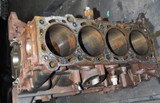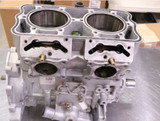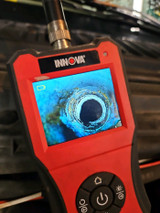Car Heater Not Working? Troubleshooting, How to Fix Repair Tips
Wise Auto Tools Summary: Easy to understand master tech tips on how to troubleshoot a car’s heater system that’s not working. It’s best to understand the basics of how it works and what makes it blow hot air. That way you’ll know how to fix your car heater if it’s blowing cold air. To put it simply, a car’s heater system transfers heat from the engine to the inside of the car. It does this by circulating the engine’s coolant from the engine and then through the heater core. Once the hot coolant, which was warmed up by the engine reaches the heater core, air is forced through the exterior of the heater core fins and tubes. Some of the heat is transferred from the coolant in the core to the air which in turn warms the air for the passenger compartment. We provide free some tips on finding and fixing problems with car heaters that are blowing cold air out the dash vents. So if your car’s heater only blows cold air out the vents, read the following car repair article to gain a better understanding on how the heater system works and how to make it blow hot again.
Engine
Combustion engines produce a byproduct of heat. Heat is generated due to friction and the small explosions that occur in each cylinder which powers our cars. “Explosions” may sound extreme but that is what occurs when spark from spark plugs ignites the fuel with the precise amount of oxygen, in each cylinder. Without the cooling system working properly the motor would overheat and be damaged. Some of this byproduct; heat from the engine transferred by the circulating coolant is used to as a benefit to heat the passenger compartment.
Thermostat
It’s a common misconception that if a car’s heater system is not working, the thermostat must be bad. It is true that if the thermostat does not open to allow coolant flow, the heater will not work. But the more immediate issue would be that the car engine would overheat which is a much more serious problem than the passenger compartment being an uncomfortable temperature. Only in very cold weather could the thermostat cause the heater NOT to work. If the temperature gauge shows “cold” even though the car has been running 5 minutes or more, it is possible the t-stat is stuck open. But, the thermostat in a car is not like the thermostat in a house’s AC/Heater system. The car’s thermostat does not regulate the temperature of the coolant specifically for the heater. It is designed to prevent the coolant from flowing until the coolant reaches a certain temp. In most cases (unless it’s very cold outside) once the thermostat is open it stays open. Again, this is not for the heater system, it is for the engine. To bring the temperature of the engine up to peak operating temperature quickly when first started. Also in very cold weather, it also helps maintain the best temperature for the engine. When the engine is at it’s optimum temperature it is more efficient. It runs smoother, gets better mileage because the fuel atomizes better so there’s less waste.
Water Pump
The water pump simply pumps the water throughout the cooling system. The water pump hardly ever just “stops pumping”. In rare cases the impeller may corrode to a point that is not able to pump. If it gets to that point the engine will be overheating. Most of the time when a water pump does fail, it leaks coolant out of a weep hole because of a leaky seal. Sometimes they will get noisy from a failed bearing. I could go into more detail on other common failures of water pumps, but for the purposes of understanding how the heater system, works; it’s important just to know that the water pump is what forces the coolant through the system.
Heater Core and Radiator
The radiator is what transfers the engine’s heat to the outside air, in the process cooling the water that get’s recirculated back through the engine cooling it. The heater core is like a miniature radiator. On a small scale it helps cool the water in the cooling system also. But it’s purpose is to heat the passenger compartment like mentioned above. Radiators that are clogged can cause a car to overheat. A heater core that is clogged can prevent the heater from working. Don’t assume that if the heater doesn’t work that the heater core is just bad. The heater core can leak or it can get clogged, but it doesn’t just stop working. One tip to troubleshoot a potentially clogged heater core and to diagnose the problem is to; feel the two heater hoses that go to the heater core tubes at the firewall. One should be very hot and the other should be very warm. If one is hot and the other is cold, there could be a clog or air trapped in the heater core. Since most of the time the heater core is at a higher elevation than the rest of the cooling system, low coolant can cause the heater core to empty into the lower parts of the cooling system. This will result in no air being warmed and therefore no hot air to be blown through the dash vents. If the coolant level is full and there’s no air in the system, a clogged heater core is the possible problem. Sometimes a heater core can be flushed out, by removing the heater hoses and spraying a garden hose through the heater core tubes. The clamps on the heater hoses may be the old type of screw clamps or they might be spring clamps that are much easier to remove if you have the proper hose clamp spring pliers. On many cars, trucks and vans it’s harder to use regular pliers because of the tight proximity the hose connections, in relation to the firewall and engine. Heater hoses can become almost melted to the heater inlet and outlet pipes. This because the rubber get’s so hot they can just stick to the tubes. *Caution – Forcing the hoses off by prying can damage the heater core. The heater hoses can be loosened by using a hose pick, being careful not to poke a hole through the hoses when working the pick under them. Once sufficiently loosened the hoses can be pulled off without damaging the heater core. These tools can be used whenever the heater hoses need to be removed, if just doing a flush or if changing the heater core.
At wiseautotools.com we have a large variety of automotive tools that will assist in fixing anything more easily. Fix More.
In some older cars, since a leaky heater core can be so labor intensive to change; owners will sometimes bypass them rather than pay to have a heater core changed. Tip: to check for a bypassed heater core look to see if the heater hoses are looped together and clamped by a union rather that going to the heater core pipes/tubes at the firewall. The heater core tubes may just be sticking out of the firewall with no hoses at all or hoses that have been cut off. Labor to change a heater cores varies greatly due to different makes and models. I’ve changed heater cores on older cars in a half an hour, but I’ve also changed heater cores that require the entire dash to be removed to access them. The hardest ones I’ve ever changed were in a Mitsubishi Diamante and one in a Chevrolet Corvette. A 1/4″ impact wrench/driver saves a lot of time when doing dash work yourself. Check the labor hours required for your model with a local shop. They can also let you know what the going shop labor rate is in your area. Usually shop labor rates are higher at the dealerships and lower at independent repair shops. Either way, just make sure the core really needs to be changed. Try the other fixes first and leave replacing the core as a last resort, like if you have coolant puddling on the passenger floor board or running underneath the carpet. If the core has been bypassed at sometime in the past, you can be assured it’s a leaker.
Heater Control Valve or HVAC Door
The amount of heat is usually controlled one of two ways. Some cars have a heater control valve (usually by the firewall in line with a heater hose) which works like a sink faucet. The heater control valve opens allowing the flow or closes preventing the flow. If no heat is desired the flow of coolant can be turned off completely. Some cars don’t have a heater valve. In those cars that don’t use a heater valve, the desired amount of heat is controlled by a door that opens and closes in the heater case. This is usually called an HVAC (Heating, Ventilation & Air Conditioning) case. It houses the evaporator, the heater core and has numerous doors that direct airflow to the proper vents (mode control) and adjusts the blend of cold and hot air so the desired temperature that comes through the vents. On a lot of cars these airflow/control doors are made of a plastic composite type material that tend to break over time which can cause blend control or mode issues. Also actuators, which are vacuum operated or little electric motors that open and close the doors can fail also. Sometimes when the electric motors fail, they will strip a plastic gear which will result in a rapid clicking noise when the AC or heat is first turned on. Other times they may continue to click indefinitely. Jeep Grand Cherokee’s dual zone problem is common, resulting from broken doors that can cause one side to work but not the other. The Dodge Ram truck fresh air door problem, is a broken door issue primarily with their fresh air door that can prevent airflow from the blower because it can fall and block the fan.
Low Coolant-Leaks in the Cooling System
What we commonly call coolant or anti-freeze is combined with water. The chemicals and additives are designed to increase the boiling point and reduce corrosion inside the cooling system/engine. There are different types of coolant on the market today, not just green. Refer to a service manual to find the correct type for your car. Some aftermarket coolants are OK for use in all models. Some need water added and some do not. Regardless of what type of coolant is being used, any leaks in a cooling system are not only going to reduce the vehicles ability to keep it’s engine cool; it will also affect the performance of the heater system. In fact the loss of heat through the vents may be noticed first, before any overheat problems with the engine occur. Sometimes low coolant, even if it’s just a little low, will make the heater blow cold air out the vents. Sometimes the heater will only blow warm when driving and blow cold at idle. If the coolant is low, use a coolant pressure test kit to pressurize the cooling system that will help reveal any leaks. Some cooling systems have a pressurized coolant overflow reservoir. You can tell if the bottle has what looks like a radiator cap instead of a plastic screw cap or pressed on cap. *Caution – regardless of where the pressurized cap is, don’t open it when the engine is hot. The hot coolant can vaporize and spray causing burns. Avoid scalding yourself or anyone standing nearby by only removing pressurized coolant caps when the engine is cold.
Air Trapped in the Cooling System
If air is trapped in the cooling system, especially in the heater core, the heater will not work. Some vehicles have bleeder screws in the cooling system that will allow air to be bled off of the system. Many newer cars will route the lines so they are self bleeding. The use of a coolant funnel is helpful when the pressurized coolant pressure cap is located on the radiator. If the pressurized coolant cap is located on the overflow bottle the funnel will not be of any use as far as bleeding the air from the system. If used on the radiator though, it is very effective. The Lisle coolant funnel is not just to keep from spilling coolant. It comes with many different adapters that fit the top of the radiator in place of the radiator cap. It holds coolant ready to go down into the system and fill the void when the air burps out. By running the car with the funnel in place, I will sometimes squeeze the upper radiator hose to help the air burp and rise. You can actually see the air bubbling to the surface in the coolant funnel. Again, if the pressurized cap is on the reservoir the funnel won’t be effective. The reservoir acts the same as the funnel does on those type of systems. Some professional technicians like to use a coolant vacuum fill method to insure there’s no air in the cooling system.
We've been selling car tools since 2005 and providing valuable information to our customers. Be sure to bookmark our website and keep us in mind for your car and light truck tool needs.
Recent Posts
-
Shorter Kits for Head Bolt Thread Repair - What are the downsides?
We recently came across an article that stated the more expensive, longer Time Sert kits made for he …28th Feb 2024 -
Polaris Head Bolt Thread Repair Kit - Information and Recommended Kit & Inserts
Aluminum head bolt threads pulling out on Polaris engines is a fairly common problem. Installing a s …23rd Jan 2024 -
How Bad Can Spark Plug Hole Erosion Get, and Can It Be Fixed?
How severely can a spark plug hole in an aluminum engine head, which previously had a repair insert …5th Dec 2023




